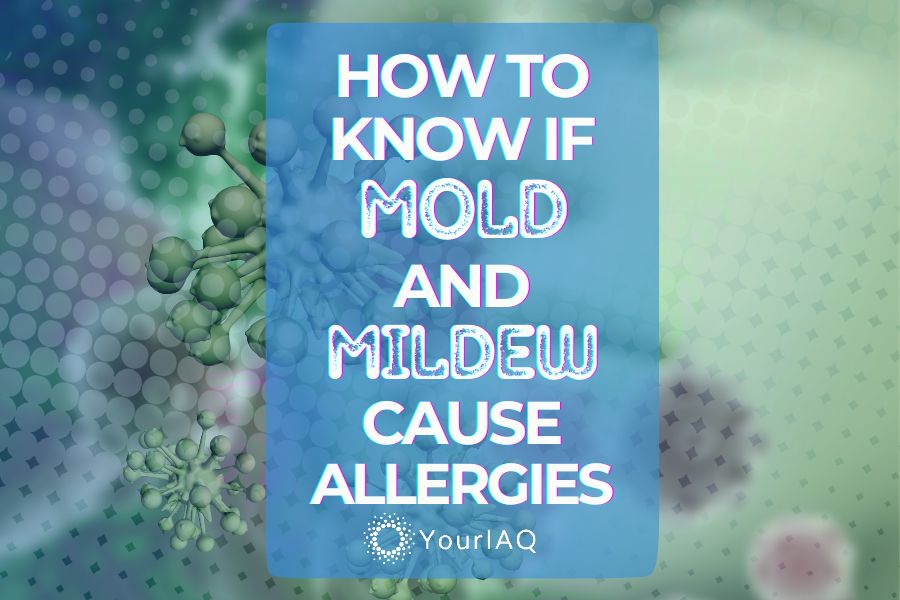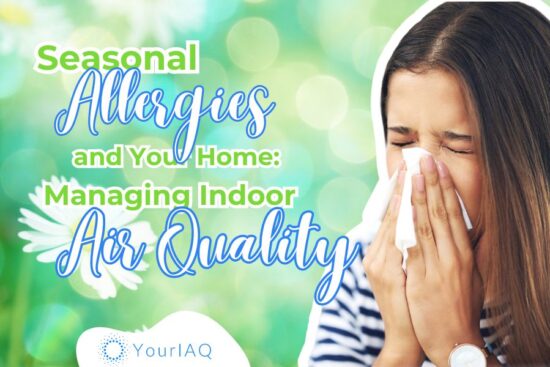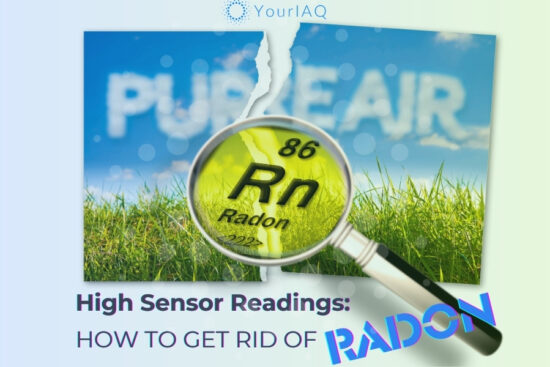
Stuffy nose, itchy eyes, constant cough…could it be allergies, or is mold lurking in your home?
Mold and mildew are types of fungi that thrive in damp environments. While they seem harmless, both can trigger allergic reactions and even cause breathing problems for some people. But how do you know if those sniffles are caused by a seasonal allergy or something growing in your home?
Let’s find out here!
Mold and Mildew: What’s the Difference?
Though used almost interchangeably, there’s a slight distinction:
Mold
- Typically green or black, but can also be red, orange, or other colors.
- Grows in fuzzy or slimy patches
- Often has a musty odor
- Tends to penetrate surfaces, growing beneath paint, wallpaper, etc.
Mildew
- Usually white or gray, sometimes with a yellow or brown tinge.
- Appears powdery or downy.
- Has a milder odor compared to mold.
- Primarily a surface growth, easier to clean.
Where They Thrive
Both flourish in the same conditions: moisture and warmth. Common trouble spots include:
- Bathrooms (especially showers and around sinks)
- Basements and crawl spaces
- Kitchens (under sinks, behind appliances)
- Leaky roofs or windows
- Areas with recent water damage
Important Note: While the color and texture are helpful clues, the only way to definitively know what you’re dealing with is through lab testing.
Further Reading: Mold Hotspots: Ranking the 5 Worst U.S. States for Mold
Why Does it Matter?
Understanding the distinction helps you choose the best cleaning methods. However, from an allergy standpoint, BOTH mold and mildew are triggers. Focus on finding and eliminating the moisture source to stop either from growing.
Could My Allergy Symptoms Be Caused By Mold?
If you’re experiencing allergy-like symptoms, could mold or mildew in your home be the culprit? Look out for these common signs of indoor mold allergy symptoms:
Respiratory Issues
- Persistent coughing
- Wheezing, difficulty breathing, or an asthma attack (if you have asthma)
Mold allergies can worsen existing conditions like asthma. To learn more about the link, see our article on Air Quality and Asthma.
- Nasal congestion or runny nose
- Sinus pain or pressure
- Post-nasal drip (sensation of mucus dripping down the throat)
If allergy symptoms worsen at night, consider dust mites or pet dander if you share your bed. However, if there’s dampness in your bedroom, mold could be a factor.
Pet dander is a common cause of nighttime allergies. Learn how to improve your IAQ with pets.
Skin Irritations
- Rash or itchy skin
- Eczema flare-ups
- Hives (raised, itchy bumps)
Eye Discomfort
- Itchy, watery, or red eyes
- Swollen eyelids
- Sensitivity to light
Other Symptoms
- Sore throat
- Headaches
- Fatigue
- Unexplained sneezing fits
- Cognitive issues (brain fog, difficulty concentrating) – this is more common in severe exposure
When Do Mold Allergies Get Worse?
- In damp rooms (bathrooms, basements, etc.)
- During humid weather conditions
- If there’s a musty odor in your home
- If you see visible signs of mold
How to Tell if Mold is Causing Your Allergies?
Mold and mildew thrive in damp conditions, and their presence can worsen or even trigger allergies. Here’s how to investigate if mold could be the culprit:
Step #1: Track Your Symptoms
The first step is becoming a detective of your symptoms. Notice when your allergy symptoms are most severe. Do they worsen in specific rooms of your house, or get better when you’re away from home for extended periods?
Track your symptoms with a notepad or an allergy-tracking app to spot patterns.
Step #2: Inspect for Visible Signs
Now it’s time for a visual hunt. Mold isn’t always obvious, but there are common places it likes to hide. Pay close attention to:
- Bathrooms: Check showers/tubs, around sinks, under cabinets
- Kitchens: Under the sink, behind the fridge, inside cabinets near outside walls
- Basements & Crawl Spaces: Look where pipes enter, around windows, and areas prone to leaks.
- Windows and Doors: Condensation or leaks can cause mold growth on frames or nearby walls.
Anywhere that’s been water-damaged: Even old, seemingly dry leaks can harbor hidden mold.
Step #3: Sniff Test
Your nose can be a powerful mold detection tool! A musty smell, even if you don’t immediately see mold growth, is a strong indicator that moisture and potential mold are present.
Step #4: Investigate Moisture Sources
Mold can’t grow without moisture. Find the source of any leaks, condensation, or excess humidity in your home. While not all molds are equally harmful, some types can produce toxins that impact your health.
- Leaky plumbing: Check under sinks, behind appliances, around toilets.
- Roof or window leaks: Look for water stains on ceilings and walls.
- Condensation: Common on cold surfaces (bathroom mirrors after showers).
- Humidifiers: If they’re not cleaned regularly, these can spread mold spores.
What to Do if You Suspect Mold
Are you concerned about mold allergies? Here are simple steps you can take to reduce moisture and keep your home less hospitable to mold and mildew:
- Control Humidity: Use dehumidifiers to keep indoor humidity levels below 50%.
- Ventilate: Ensure proper ventilation in high-moisture areas.
- Fix Leaks: Repair any plumbing leaks or water damage promptly.
- Clean Regularly: Clean and dry areas prone to mold growth regularly.
When to See a Doctor about Mold Allergies
See a doctor if you have allergy-like symptoms that:
- Last longer than a few weeks
- Are severe or interfere with daily life
- Don’t respond to over-the-counter allergy medication
An allergist can do tests to pinpoint the cause of your symptoms and recommend treatment options.
Use this to find an allergist using your zip code: https://acaai.org/find-an-allergist/
Conclusion
Recognizing the symptoms of mold and mildew allergies is the first step toward creating a healthier indoor environment. By taking proactive measures to identify and address mold and mildew, you can alleviate allergy symptoms and improve your overall well-being.
Mold & Mildew Allergy Symptoms FAQs
Need quick answers about mold allergies? Here are some frequently asked questions:
Can mold and mildew allergies occur year-round?
Yes, mold and mildew can grow indoors any time of the year, making allergies potentially year-round issues, especially in consistently moist environments.
How can I tell the difference between mold and mildew?
Mildew is typically white or gray and powdery or fluffy in appearance, found on surfaces. Mold is usually black, green, or red and appears fuzzy or slimy, often growing beneath surfaces.
Are mold and mildew allergies, serious?
In rare cases, severe reactions like headaches, fatigue, or nausea can occur, especially for those with weakened health.
Should I test my home for mold?
If you see or smell mold, or if allergy symptoms persist despite cleaning, consider testing your home for mold. Professional testing can identify the type and extent of mold presence.
Can a little bit of mold make you sick?
The amount of mold needed to trigger a reaction varies by person and mold type. Some people are more sensitive than others.
Is all mold in homes dangerous?
No. While some molds can be harmful, many common household types aren’t dangerous to healthy individuals.
How long does it take for mold allergies to show up?
Reactions can be immediate for those already sensitive. If it’s a new allergy, it might take repeated exposures to develop symptoms.
How do you know if mold is making you sick?
If allergy-like symptoms worsen indoors, last longer than usual, or don’t respond to allergy meds, suspect mold.
How do I know if my allergies are from mold?
An allergist can do tests to pinpoint your triggers. If symptoms improve when you’re away from home for extended periods, mold is a likely culprit.
What should I do if I suspect mold allergies?
Focus on controlling moisture in your home and cleaning any visible mold. If symptoms are severe or persist, see a doctor.







